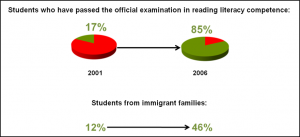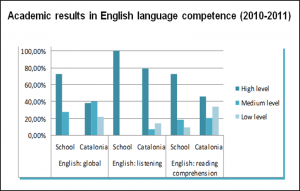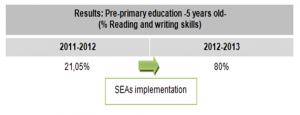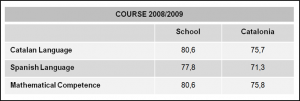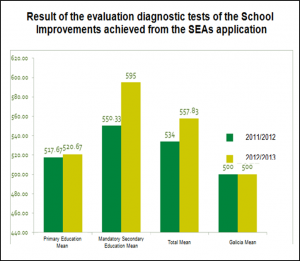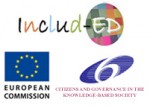INCLUD-ED’s has identified Successful Actions with universal components transferable across contexts. The implementation of these universal components during and after the INCLUD-ED’s Project in different territories has obtained relevant social impacts. That is, improving educational outcomes, enhancing social cohesion or increasing opportunities and quality of life for the population from the point of view of economic development (creating new jobs or identifying actions that generate new jobs) and quality of live. These social impacts have been achieved through the communicative research perspective that allowed a direct and active participation of the people whose reality was being studied throughout the entire research process. Their voices have been taken into account in order to contribute to overcome their difficulties.
MORE INFORMATION:
(Flecha & Soler, 2013) Abstract; Full Text
(Burgués, Martin & Santa Cruz, 2013) Abstract; Full Text
(Gómez, Puigvert & Flecha, 2011) Abstract; Full Text
Social impact 1: Reducing absenteeism and early school leaving *
Evidence: Overcoming of the absenteeism (from 30% to occasional) in 3 academic years. La Paz Primary School (highly deprived area, Albacete).
Source: Flecha, R., & Soler. M. (2013). Turning difficulties into possibilities: engaging Roma families and students in school through dialogic learning. Cambridge Journal of Education, 3(44), 0305-764X. doi: 10.1080/0305764X.2013.819068 Abstract; Full Text
Evidence: Overcoming of the absenteeism (from 60% to occasional) in 1 academic year. Mediterrani School (highly deprived area, Tarragona).
Source: School Data
Social Impact 2: Increase in school performance (performance rates) *
Evidence: High increase in the score in La Paz Primary School (highly deprived area, Albacete).
- Increase of the scores in all subjects in standardized tests in one academic year (9 year old students).
- Increase the scores in mathematics from 1 to 3 (out of 5) in the standardized tests.
- Increase the scores in cultural and artistic skills, social and citizenship skills, learning to learn, autonomy, and emotional skills from 2 to 3 (out of 5) in the standardized tests.
Source: Flecha, R., & Soler. M. (2013). Turning difficulties into possibilities: engaging Roma families and students in school through dialogic learning. Cambridge Journal of Education, 3(44), 0305-764X. doi: 10.1080/0305764X.2013.819068 Abstract; Full Text
- The percentage of children perceiving that they had improved ‘very much’ in mathematics increased from 63.89% to 94.59% from 2006-2007 to 2009-2010.
Source: Flecha, R., & Soler. M. (2013). Turning difficulties into possibilities: engaging Roma families and students in school through dialogic learning. Cambridge Journal of Education, 3(44), 0305-764X. doi: 10.1080/0305764X.2013.819068 Abstract; Full Text
Evidence: Increase of the scores in a school with high rates of migrant students.
- Increase in the percentage of students who pass the official exam on reading skills: from 17% to 85% in 5 years (2001-2006).
Source: School Data
- The school has scored above the average grade at the regional standardized test on language skills in English (2010-2011).
- 100% of students pass the listening skills exam (2010-2011).
Source: School Data
Evidence: High increase of the scores in a school with high rates in Roma student population (Catalonia).
- Increase of a 58,95% in the percentage of students who achieve read and write skills in pre-primary education (5 years old) in 2012-2013.
Source: School Data
Evidence: Increase of the scores in Alberich i Cases Primary School (Middle-Class Schools).
- Score above the average grade at the regional standardized test overpassing by 4.9% the results in Catalan language, by 6.5% in Spanish language and by 4.8% in mathematics.
Source: School Data
- The average of 6th grade students obtain 92.5 points in the standardized tests in mathematics in the 2011-2012 academic year. In the same period the students with special educational needs are increased by 11%, and foreign students in a 10%.
Source: School Data
- In 2010, all students completed the initial and advanced cycle and 98% of students completed successfully the intermediate stage.
Source: School Data
Evidence: Increase of the scores in a Rural school, North of Spain (in Castroverde Pre-school and Primary School).
- The school has scored above the average grade at the regional standardized test both in primary education and secondary education in 2011and 2012 academic years.
Source: School Data
MORE INFORMATION:
Díez, D., Gatt, S., & Racionero, S. (2011). Placing Immigrant and Minority Family and Community Members at the School’s Centre: the role of community participation. European Journal of Education, 46(2), 184–196. doi: 10.1111/j.1465-3435.2011.01474.x Abstract Full text
Valls, R., & Kyriakides, L. (2013). The power of Interactive Groups: how diversity of adults volunteering in classroom groups can promote inclusion and success for children of vulnerable minority ethnic populations. Cambridge Journal of Education, 43(1), 17-33. doi: 10.1080/0305764X.2012.749213 Abstract Full text
Elboj, C., & Niemelä, R. (2010). Sub-communities of Mutual Learners in the Classroom: The case of Interactive groups. Revista de Psicodidáctica, 15(2), 177-189. doi: 10.1387/RevPsicodidact.810 Abstract; Full Text
Social Impact 3: Expansion in number of schools implementing SEAs *
Evidence: In 2014, there are more than 200 Learning Communities, schools that are implementing SEAs, after the INCLUD-ED Project.
Source: Learning Communities
Evidence: Approximately 70 schools in Brazil and 23 schools in Peru, Mexico and Colombia are implementing SEAs (promoted by Natura Institute).
Source: Natura Institute
Evidence: More than 50 parent’s associations in Catalonia are implementing SEAs through the Xarxa-Clau Project (developed by the Federation of Parents’ Associations of Catalonia, FaPaC).
Source: Xarxa-Clau Project
Social impact 4: Creation of employment in locations of extreme poverty *
Evidence: 586 jobs in one of the poorest neighborhoods in southern Europe (Miguel Fenollera cooperative), 10 permanent positions in the cooperative, 570 contracts in the agricultural sector and 6 in the educational sector.
Source: Miguel Fenollera cooperative data
MORE INFORMATION:
Burgués, A., Martin, S. & Santa Cruz, I. (2013). La relación entre cooperativas transformadoras y desigualdades sociales en los territorios [Special Issue]. Scripta Nova, 427(XVII). Abstract; Full Text
Flecha, R.; Soler, M. (2014). Communicative methodology. Successful actions in dialogic democracy. Current Sociology, 62, 232-242. http://csi.sagepub.com/content/62/2/232?etoc Abstract; Full Text
INCLUD-ED social impact stories *
A 10 year old pupil from a school with high rates of migrant pupils explained in the European Parliament her own and her classmates’ experience with Successful Educational Actions (SEAs). As Ania shows in the video: they learn more and they are more united.
Mr. Rafael Layón, current member of the Miguel Fenollera Cooperative and neighbour in one of the poorest neighbourhoods in southern Europe explained his own experience in overcoming exclusion through SEAs during INCLUD-ED’s Final Conference. As he explains in the video: he and other neighbours have overcome situations of extreme vulnerability after participating in SEAs.




